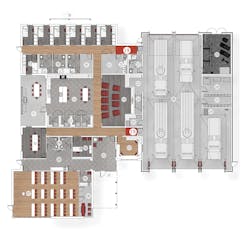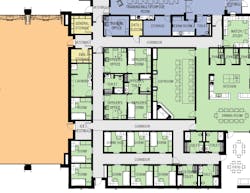The design of a modern fire station is a complex effort that must address the financial, operational, administrative, and security requirements for first responders and their organizations. The overall functionality of the design must meet the stringent criteria that are established during the planning and programming phase. The creation of a public and private sector within the design is paramount to this effort.
The public sector of the station must meet the administrative needs of the fire department in providing an office core, an administrative support area, conference areas and, often, large meeting rooms or community centers. The latter often provide the venue for community group meetings, training events, public education and community risk reduction (CRR) classes.
With the development of the public core, the design then must focus on the creation of a sense of entry into the building. This should include an identifiable entry point that draws the public to the entry and offers a portal to the interior space. The entry vestibule and corresponding lobby/reception should be inviting and offer a communal gathering area prior to the formal entry. The vestibule should be designed to minimize the potential for hidden areas and might include the staggering of the doors to restrict direct linear access—unlike conventional design, where door alignment would enhance and ease access flow.
Within a security-focused design, the offsetting doors create a passive restriction or hindrance for uninvited persons. Additionally, the use of glazing is encouraged unless the site-specific location or orientation suggests a higher level of security. The main entrance portal or the common area often includes the point of entry reception counter or an administrative counter to offer internal direction or guidance to the public or visitors to the station. This location also becomes the “security checkpoint” after entry and might be equipped with electronic door releases, occupancy sensors and security cameras to monitor unwarranted access to the facility. Additionally, thought should be given to the location of support functions for the public area, such as storage areas, coffee and vending components and public restrooms. All such support function will be required, but it’s imperative that they be positioned exclusively in the public zone. This minimizes the potential for passage doors being left open and eliminates cross access to the restrooms by the public or by visitors to the station.
Not for public access
Once the public sector is established, a passive security effort should be employed by means of secured doors to restrict access from the public function to the private function areas. The private sector itself should include similar zones within the area to create a well-functioning core for the firefighting shift personnel. Within this zone, consideration should be given to overall circulation between the dayroom, kitchen and the dining area. Very similar to residential design, there is a certain specific relationship between these areas that fosters a sense of family within the firehouse. The sleeping core should be located adjacent to—but isolated from—the dayroom/kitchen/dining area for privacy concerns. Within the sleeping, or bunkroom, core, the actual bunkrooms should be harnessed around the locker room, the shower rooms and the toilet facilities. Circulation within this area should be considered and should include direct links to the functions that are noted above but also should include isolation doors to better define the space and to provide the opportunity for the design team to introduce zoning of the HVAC system.
Once the main programming aspects of the project are addressed, the project moves into the schematic design and design development phases. At this time, the passive and active safety and security aspects should be layered into the design plan. A well-thought-out space plan that uses the zoning concepts that are discussed above creates the foundation for a security-focused design. The isolation of the public area from the private area is paramount in limiting access to the private side of the fire station. This isolation is as simple as providing access-controlled doors at the entry points from public to private. In some instances, the physical construction of the wall that’s between these areas might be part of the passive security system. Contingent on the design, the location of the high roof structure and the low roof structure may coincide with the location of this isolation or barrier wall. This wall might then be constructed of masonry for structural purposes while offering a hidden security barrier. When this structural wall doesn’t correspond with the separation wall, a fortified nonstructural wall may be considered. The selection of “hard” materials, such as cement board, fiberglass reinforced panels or monolithic tile finishes, might harden the wall construction while suggesting a design-oriented purpose. In certain applications, the addition of a layer of plywood or other similar product as a substrate can afford the hardening attributes that are needed. Both methods enhance station security and most likely will be undetected by the public eye.
Additionally, within the private core, zoning, circulation paths and door orientation also can be a passive attribute to safety and security within the firehouse. Safety measures within the private zone can include air locks that inhibit passage of toxins or contaminants between the private side and the apparatus floor. A very effective and efficient method to foster this separation is to create an airlock within the connection corridor between the private side and the apparatus floor. This airlock is created by positioning two independent doors within the connective corridor, which essentially minimize air flow from one side to the other. Often, this internal airlock can be set to a slightly negative design pressure to capture any potential contaminants.
These airlocks that have the double-door configuration also can contribute to station security when both sets of doors are equipped with a locking mechanism. During station visits and design conversations, there has been an increase in the use of this passage concept. However, the added level of security hasn’t been developed fully.
Station hardening
The structure itself should be evaluated and a determination made as to the degree of hardening that’s warranted. The point to be made is that hardening a structure for natural destructive forces also inherently enhances the active security measures for the firefighting personnel therein.
With the potential for both natural destructive forces and intentional acts, these structures, or portions of the structures, should be hardened and protected whether by means of a passive or active protective system.
Passive systems include those that aren’t obvious or detectable in the design; active systems include obvious fortification or hardening efforts, such as fenestration and opening protections, minimized low-access glazed openings, sloped windowsills (to deter the placement of explosive devices), protective isolation barriers and natural standoff zones. Some can appear decorative in nature.
Sloped windowsills can be viewed as an architectural detail while minimizing water infiltration potential.
Decorative raised landscape planters that enhance the project’s hardscape design can act as a vehicular barrier based on their configuration and design. The addition of minimal steel reinforcing within the planter wall can be designed to withstand vehicular impact.
Natural destructive forces typically correspond to geographic locations (e.g., tornadic events in the Midwest, high wind velocity along coastal regions, accumulating snowloading in the northern regions, and earthquakes in fault or seismic zones). The adopted building code of the area in which the station is built will dictate the code-required structural design requirements, but often these structures should be designed to withstand a moderate increase in these forces. So, although increasing wind-loading resistance and seismic resistance creates a more resilient structure for natural events, it provides a slightly more hardened structure in the event that the fire station is the target of an intentional act.
About the Author

Ralph DeLuca
Ralph DeLuca is a 38-year veteran of the fire service and recently retired as the fire chief of a fire protection district in suburban Chicago. During his tenure in the fire service, he attained a Bachelor of Architecture from the University of Illinois, and he is a licensed architect in multiple states. Additionally, DeLuca attended numerous building assessment and forensic analysis programs and completed forensic evaluations of compromised structures. He also provides instruction on technical rescue response, firefighter safety and structural collapse response at the Illinois Fire Service Institute and is a structures specialist on IL TF-1.

